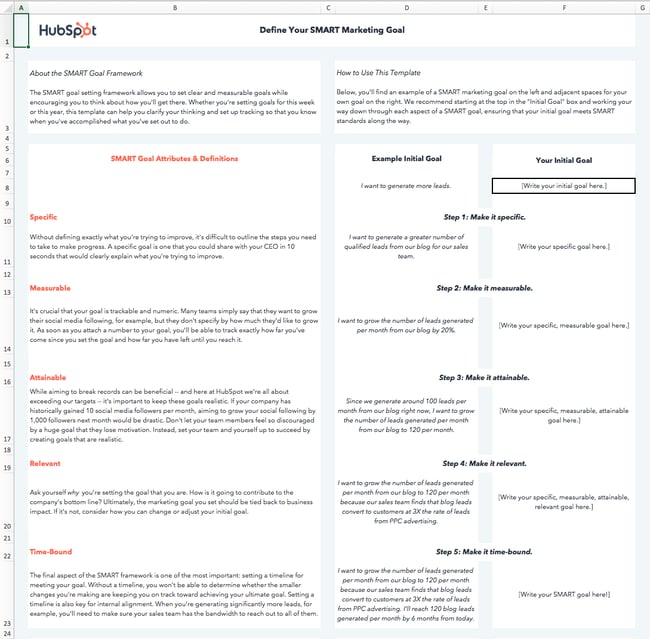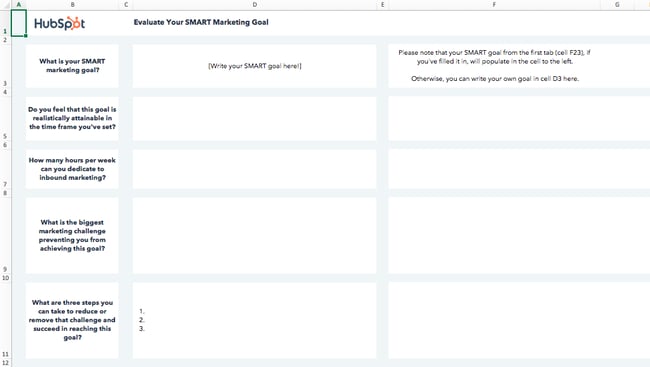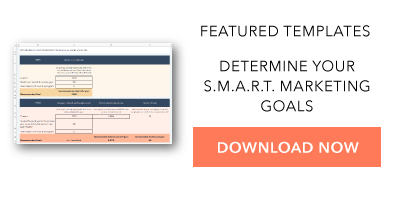How to Write a SMART Goal [+ Free SMART Goal Template]
Work can feel like a never-ending grind when you’re not chasing a clear goal. A SMART goal template can help you clarify your motivations, set a clear direction for you and your team members, and ensure you’re able to celebrate the wins when they come along.
But what exactly is a SMART goal, and how does it differ from a regular goal?
To help you write SMART goals, we’ve created a free template with all the tools you need to get started.
What is a SMART goal?
The letters of SMART stand for:
- Specific
- Measurable
- Attainable
- Relevant
- Time-Bound
The SMART acronym is a framework that will enable you to write goals that drive greater impact. Write goals with each of these aspects in mind, and you’ll be able to quantify how far you’ve come and how far you have left to go against your goal.
When you reach the milestone you articulated in your SMART goal, you’ll be able to celebrate knowing that you achieved something tangible and impactful.
To make setting a SMART goal simple, we’ve created a free, downloadable SMART goal setting template.
I’ll walk through the template below as we discuss each aspect of a SMART goal.
I’d suggest downloading the template yourself to follow along with this blog post. However, before anything else, let’s dive into the importance of each aspect of the SMART acronym.
What does each aspect of the SMART acronym mean?
While we run through the definition of each aspect of the SMART goal framework, we’ll apply the framework to a real-world example.
Let’s start with a basic, non-SMART goal as our example — “I want to get fitter.”
1. Specific
Goal setting is often associated with striving toward our highest aspirations, and reaching those aspirations can seem daunting. Specificity helps us determine the path between where we are and where we want to be.
- Ambiguous goal: “I want to get fitter.”
There are innumerable ways to get fitter, and everyone has their own definition of fitness. For instance, do you want to lose weight? Do you want to perform more push-ups? Or do you want to cut a minute off your mile time?
When a goal isn’t specific, there is no way to tell whether your actions will help you achieve that goal or not. If your specific fitness goal is to increase the number of push-ups you can do, then following a running plan will not be very helpful in getting you to your true goal.
- Specific goal: “I want to be able to do more push-ups.”
A specific goal makes your next steps clearer or, at the very least, narrows down the next steps you are going to take.
Make your goal more specific and type it into the cell under Step 1.

2. Measurable
When a goal is measurable, you can easily track your progress. Typically, this means that a number will be attached to your goal.
- Immeasurable goal: “I want to be able to do more push-ups.”
- Measurable goal: “I want to be able to do 25 push-ups in a row.”
A numerical goal is valuable for many reasons. In addition to giving you something to strive toward, you’ll be able to celebrate a victory when you reach the final benchmark.
If you say that you just “want to do more push-ups,” does that mean that you want to complete just one more push-up per session, or that you want to double the number of push-ups you can do overall? One goal will take a lot more time and dedication than the other.
Let’s say I can do 10 push-ups in a row right now. To measure our progress against our final goal and to determine whether we’ve reached a milestone, we’ll edit our push-ups goal to read, “I want to be able to do 25 push-ups in a row.”
3. Attainable
Big aspirations are admirable, but it’s important to balance long-term goals with more achievable, short-term goals.
Setting attainable goals is all about looking at what you’ve done so far and adjusting your goals to be more realistic in relation to those benchmarks.
To consider the point in more concrete terms, think about business growth rates if your company has been selling 2% more product each month for the past 12 months:
- Unattainable goal: Sell 15% more product next month.
- Attainable goal: Sell 3% or 4% more product next month.
- Unattainable goal: 25 push-ups.
- Attainable goal: 20 push-ups.
Keep in mind that 2% growth is the status quo. Selling 4% more product would still be doubling your month-over-month growth.
Attainable goals are useful because they help you maintain momentum. It can be discouraging to miss huge targets, but consistently making small gains will encourage you to continue delivering wins.
Each month, you’ll be aiming for the familiar satisfaction of hitting your target rather than dreading another seemingly major miss.
Of course, there’s still a significant amount of work required to get to where I want to be, but I’ll be able to celebrate a huge achievement like doubling the number of push-ups I can do, and use that momentum to drive me in setting a goal of doing 25 push-ups soon after I achieve my goal of 20.
Consider what you’ve done in the past in relation to the goal you’re in the process of setting, and adjust it accordingly.
4. Relevant
Relevant goals will help you move in the direction you truly desire. You can allocate your time to an infinite amount of activities, but which activities will push you closest to your ultimate goals?
It’s a common trap to feel like we’re being productive when we’re busy, even if our action isn’t creating a meaningful impact.
In the beginning, our example goal was to “get fitter.” To ensure our goal is relevant, we need to ask ourselves if following through on this goal will help us get to where we want to be.
In the case of our push-up goal, the answer is yes.
- Irrelevant goal: “I want to be able to do 20 push-ups in a row,”
- Relevant goal: “I want to be able to do 20 push-ups in a row to improve my overall muscular fitness.”
Push-ups engage several muscle groups, including your back, arms, shoulders, and core, and consecutively doing a significant number can elevate your heart rate.
Executing this goal will improve my muscular strength and perhaps even my cardiovascular strength, which are key elements to overall fitness.
Ask yourself if the goal you’ve set will create a real impact on your overarching targets, then adapt it or identify a way to track its impact if the answer is currently no.
5. Time-bound
The final letter of the SMART acronym stands for time-bound. You should always aim to accomplish your goal within a specific time period. Adding a time frame will motivate you to take consistent steps every day toward your goal. In addition, setting a timeline or time boundaries allows you to track how much progress you’ve made toward your goal based on the amount of time that’s passed.
- Goal that isn’t time-bound: “I want to be able to do 20 push-ups in a row to improve my overall muscular fitness.”
- Time-bound goal: “I want to be able to do 20 consecutive push-ups two months from now to improve my overall muscular fitness.”
If I aim to increase the number of push-ups I can do from 10 to 20 in two months, I can set a midpoint milestone of adding five more push-ups in the first month. However, if a month passes and I’ve only increased the number by three, I’ll know I need to ramp up my efforts, re-evaluate my strategy, or perhaps adjust the time frame I initially chose.
A time frame can help you chart your progress. Now, I have a goal that clarifies the path to where I want to be.
In the final tab of the SMART goals template, you’ll be able to document the roadblocks to achieving your goal that you anticipate and make an action plan for overcoming those roadblocks to set yourself off on the right foot.
Before I made my goal SMART, it would’ve been easy for me to make excuses. It wasn’t clear how I’d measure my progress or keep myself on track toward my goal.
Still need some help creating your SMART goals? You have a variety of worksheets at your disposal to help you establish SMART objectives. We’ve listed our favorite ones below.
1. Hubspot’s SMART Goal Template
HubSpots’ SMART goal template will help you design effective marketing goals with measurable, time-bound results. It’s particularly useful if your key objectives are related to increasing traffic and conversions across your online properties.
We’ll teach you how to fill it out below, but remember: You can adjust it and customize it as you see fit. If you work for a customer service organization, for instance, you could change “Monthly visits” to “Incoming customer service calls,” then aim to increase first call resolution rate.
Because it lives on a Google Sheets file, HubSpot’s worksheet is ideal for collaborative SMART goal setting. Everyone in your team can access, comment, and edit the file with a Google Workspace account.
Step 1: Define your SMART goal.
Start by defining your SMART goal using the Define your SMART goal sheet.
- Write your goal next to the example goal in Your Initial Goal section.
- Make your goal specific by defining exactly what you want to accomplish. Write the specific goal next to the example goal in the Make it specific section.
- After specifying your goal, make it measurable by including quantifiable KPIs that you would like to reach. Write your new specific, measurable goal next to the example in the Make it measurable section.
- After making your goal measurable, make it attainable by setting realistic expectations. Write your new specific, measurable, attainable goal next to the example in the Make it attainable section.
- After making your goal attainable, make it relevant by asking yourself why you are setting the goal. Determine the impact that achieving the goal will have on your business. Write your specific, measurable, attainable, relevant goal next to the example in the Make it relevant section.
- Lastly, make your goal SMART by making it time-bound. Set a timeline that will keep you on track to achieve the goal.
Step 2: Calculate your SMART goal.
After defining your SMART goal, you can calculate recommended target metrics for site visits, leads, and customers using the Calculate your SMART goal sheet.
Visits
- Enter your current number of monthly site visits in the cell to the right of Current.
- Enter your month-over-month % increase goal in the cell to the right of Month-over-month % increase goal.
- Enter the number of months you have to achieve your goal in the cell to the right of How many months out is your goal?
- The template will calculate a recommended monthly traffic goal.
Leads
- In the cell to the right of Current in the Average number of monthly website visits column, enter your current number of monthly site visits.
- In the cell to the right of By what % would you like to increase your visitor-to-lead conversion rate each month?, enter your desired % increase of your monthly visitor-to-lead conversion rate.
- Enter the number of months you have to achieve your goal in the cell to the right of How many months out is your goal?
- In the cell in the Visitor-to-lead conversion rate column and Current row, enter your current visitor-to-lead CVR.
- The template will estimate the number of leads your website generates a month. The template will also calculate a recommended visitor-to-lead CVR goal and monthly lead goal.
Customers
- In the cell to the right of Current in the Average number of monthly website visits column, enter your current number of monthly leads.
- In the cell to the right of By what % would you like to increase your lead-to-customer conversion rate each month?, enter your desired % increase of your monthly lead-to-customer conversion rate.
- Enter the number of months you have to achieve your goal in the cell to the right of How many months out is your goal?
- In the cell in the Lead-to-customer conversion rate column and Current row, enter your current lead-to-customer CVR.
- The template will estimate the number of customers your website generates a month. The template will also calculate a recommended lead-to-customer CVR goal and monthly new customer goal.
Step 3: Evaluate your SMART goal.
After calculating the recommended target metrics for your SMART goal, you can evaluate your goal using the questions on the Evaluate your SMART goal sheet. This sheet will prompt you to think critically about your goal, identify challenges that may make it difficult to achieve the goal, and brainstorm steps that you can take to remove the challenges and achieve your goal.
- Write your SMART goal in the cell next to What is your SMART marketing goal? If you have defined a SMART goal using the first sheet, the goal will populate this cell.
- In the cell below your SMART goal, answer the question, “Do you feel that this goal is realistically attainable in the time frame you’ve set?”
- In the next cell, enter the number of hours you can dedicate to inbound marketing.
- In the next cell, enter the biggest marketing challenge preventing you from achieving the goal.
- In the last cell, enter 3 steps you can take to reduce or remove the challenge and succeed in reaching your goal.
2. Organized 31’s SMART Goals Template
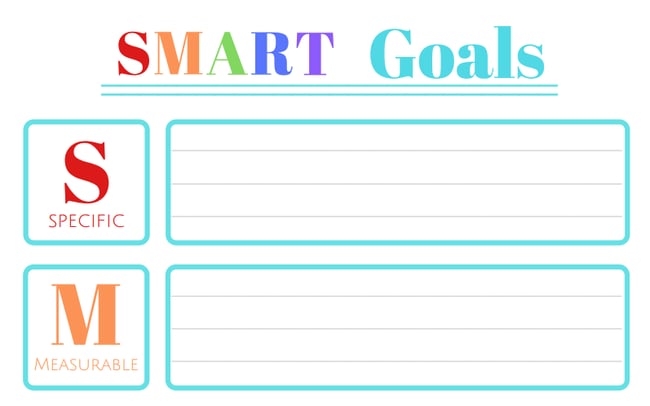
This simple SMART goal worksheet by Organized 31 is a great fit for you if you’d like to create your SMART goals as quickly as possible. It provides five boxes to fill out, each one dedicated to a letter of the SMART acronym. A big plus? It can be used both at work and at home.
Here’s how to fill it out:
Specific
In this section, clearly define your goal. Determine what you will accomplish, the resources you have available, why the goal is important, who will do the work to accomplish the goal, and where the goal will be accomplished.
Sample scenario: Instead of setting a goal to get rich, set a specific goal of having enough money to buy a house.
Measurable
In this section, determine how you will measure your progress toward the goal. Use questions such as “How much?” and “How long?” to make your goal measurable.
Sample scenario: Instead of setting a goal to gain more social media followers, set a measurable goal of gaining 1,000 new followers.
Achievable
In this section, determine how you will achieve the goal. Determine the resources you will need and the amount of time you can allot to achieve the goal. Also, consider whether you have the necessary skills to achieve the goal.
Sample scenario: Instead of setting a goal of gaining 10,000 followers in the first six months, a social media team may set a more achievable goal of gaining 500 followers by the end of the year.
Relevant
In this section, determine if your goal is meaningful and relevant to your other goals. Determine if the goal supports your mission and if it’s the right time to pursue the goal.
Sample scenario: Instead of an online retailer setting a goal of increasing foot traffic, they may set a more relevant goal of increasing their leads by 15% in the first quarter.
Time-Bound
In this section, determine the deadline for your goal. In addition, consider what you can do in the coming days, weeks, or months to progress toward your goal.
For instance, rather than simply writing a novel, set a more time-bound goal of writing a 100,000-word novel in a year by writing 300 words a day.
3. IntelliHR’s Goal-Setting Template
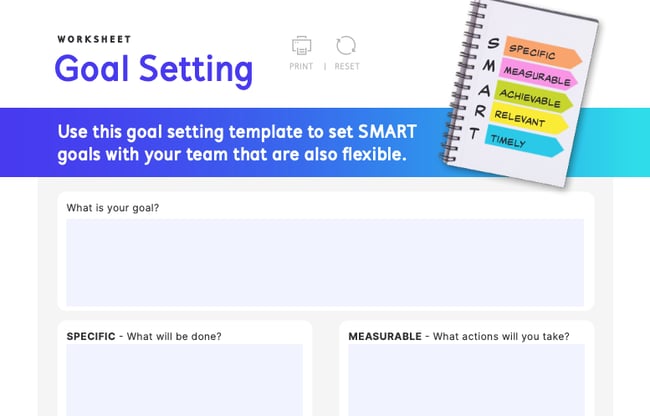
IntelliHR’s goal setting worksheet is ideal for managers who want to establish SMART goals with or for their teams. It’s an online fillable PDF file, making it easy to distribute among your team members.
Here’s how to fill out each section:
What is your goal?
The first step to completing IntelliHR’s goal-setting template is to define your team’s goal. For instance, your team’s goal may be to bring more traffic to your website. At this stage, your goal doesn’t have to be too focused. Write your goal in the What is your goal? box.
Specific
After determining your goal, make it specific — detail exactly what your team has to do for the goal to be met. For instance, your team’s specific goal may be to increase website traffic by 10% in the next year.
Measurable
After making your goal specific, make it measurable. List the actions you will take to meet your goal. For instance, your team’s measurable goal may be to increase website traffic by 10% by posting ads and sponsored content on social media that will lead more of your target audience to visit your site and improve your CTR.
Achievable
After making your goal measurable, make it achievable. List the resources you will need to meet your goal. For example, to increase website traffic by 10% by posting ads and sponsored content on social media, your team will need to launch advertising campaigns and reach out to celebrities who may be interested in endorsing your brand and participating in sponsored content.
Relevant
After making your goal achievable, make it relevant. Consider how your goal contributes to your business’ overall goals. For instance, increasing website traffic by 10% by posting ads and sponsored content may be beneficial for businesses with a strong social media presence, but for businesses with little or no social media presence, the goal of increasing website traffic may not align with their other goals.
Timely
After making your goal relevant, the last step is to make it timely. Consider the amount of time you can allot to this goal every week. This template also factors in your workload, as a busy schedule may limit the amount of time you have to complete your goal.
4. Hirebook’s SMART Goals Template
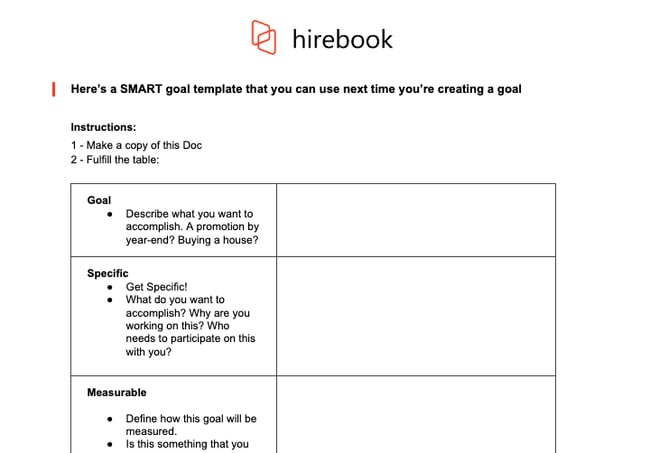
This SMART goal worksheet from Hirebook lives on a Google Docs file, making it an excellent choice if you want your team to collaborate on one documents. It also offers the simplicity of Organized 31’s template with a more workplace-friendly color palette.
Here’s how to fill it out:
Goal
The first step to completing Hirebook’s SMART Goals Template is identifying your goal. The template gives you a few examples, such as “Buying a house,” to help you brainstorm ideas for goals. Write your goal here.
Specific
The next step is to make your goal specific. The template includes a few questions, such as, “What do you want to accomplish?” and “Who needs to participate in this with you?” to help you narrow the focus of your goal as much as possible. Write a more specific version of your goal here.
Measurable
After making your goal specific, make it measurable. Determine how you will quantify the goal. How much do you need to increase or decrease a metric to reach your goal? How will you know that the goal has been met? Write the answers to these questions here.
Achievable
After making your goal measurable, make it achievable. How do you know that you can fulfill the goal? What past experiences have you had that make you capable of achieving the goal? Do you have access to the resources you need to accomplish the goal? Is this goal realistic when you consider time and financial limitations? Write the answers to these questions here.
Relevant
After making your goal achievable, make it relevant. Define how the goal is relevant to you, your business, and your long-term needs. Is this the right time to focus on this goal? Write about the relevance of the goal here.
Time-Bound
After making your goal relevant, the last step is making it time-bound. To keep yourself and your team accountable, you need to set a deadline for accomplishing this goal. When should this goal be completed? What can you do today to work towards completing your goal? What can you do in the next 6 weeks? The next 6 months? Establish a timeline and write it here.
5. SpriggHR’s SMART Goals Worksheet
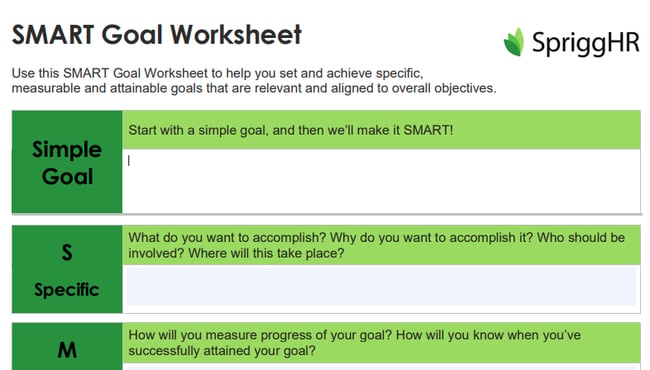
SpriggHR’s goal setting worksheet is available in three file types: A fillable online PDF file, an Excel spreadsheet, and a Word document. Because it offers three flexible options, it’s a great choice if you don’t want to use a Google Doc document or force your team to use a certain file type. You and your team members can choose what works best on an individual basis.
Here’s how to fill it out:
Simple Goal
The first step to completing SpriggHR’s SMART Goals Worksheet is coming up with a simple goal. This goal will be the basis of your SMART goal.
Specific
After creating a simple goal, the next step is making it specific. What exactly do you want to accomplish, and why? Who should be involved in this process? Where will the process take place? Write the answers to these questions here.
Measurable
After making your goal specific, the next step is making it measurable. How will you measure your goal’s progress? How will you know when you’ve successfully attained your goal? Write the answers to these questions here.
Attainable
After making your goal measurable, the next step is making it attainable. Is the goal attainable with your current skills and resources? If not, can you obtain new skills and resources to help you attain the goal? Write the answers to these questions here.
Relevant
After making your goal attainable, the next step is making it relevant. Is this goal a priority? How does it align with your team’s overall objectives? Write the answers to these questions here.
Timely
After making your goal relevant, the next step is making it timely. What is the deadline to achieve this goal?
SMART GOAL
The last step of this worksheet is taking your answers from the previous sections and rewriting them in a sentence or two to turn your simple goal into a SMART goal.
Start practicing smarter goal setting. Download a SMART goal template today.
Whether your goals are personal or professional, working toward them will never feel like a grind when you set SMART goals. Make sure every goal you set is specific, measurable, attainable, relevant, and time-bound by downloading one of these SMART goal templates today.
Editor’s note: This post was originally published in September 2019 and has been updated for comprehension.
![]()



